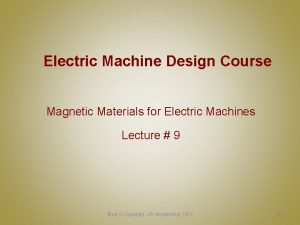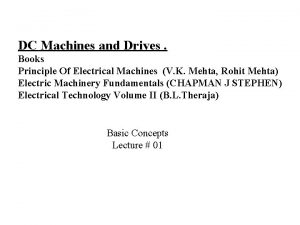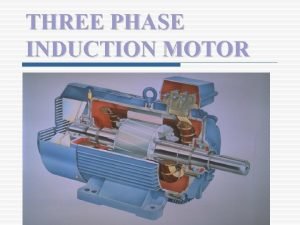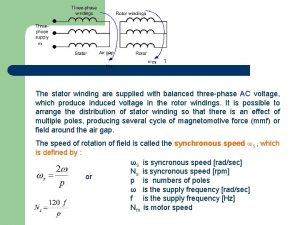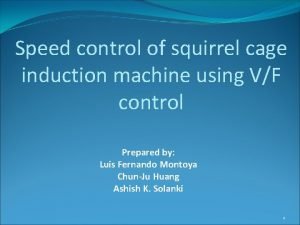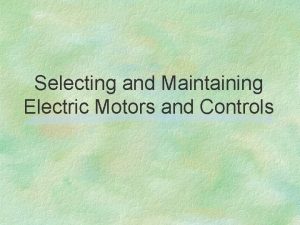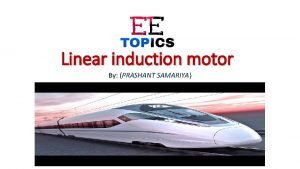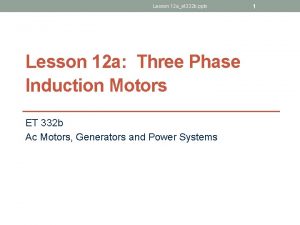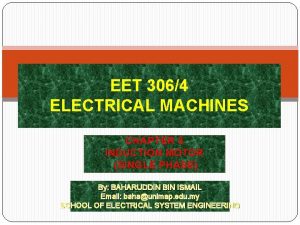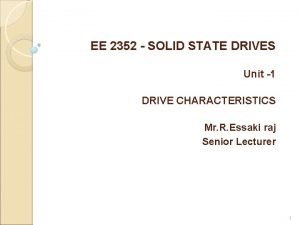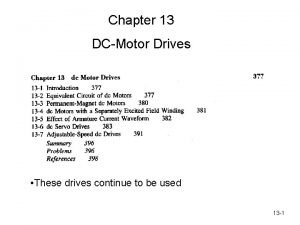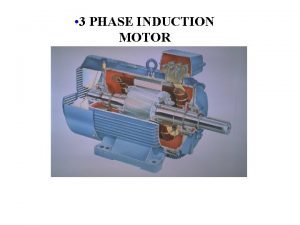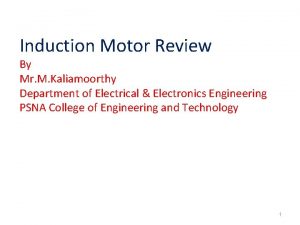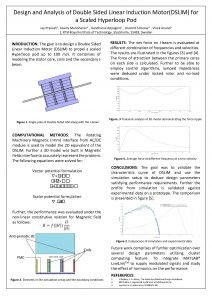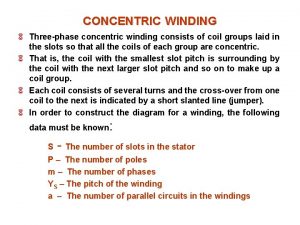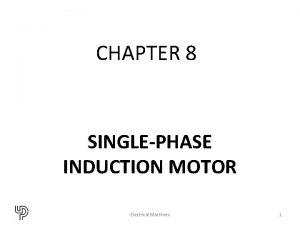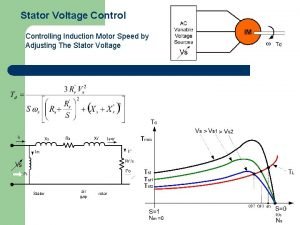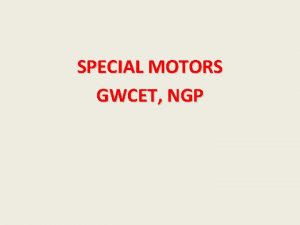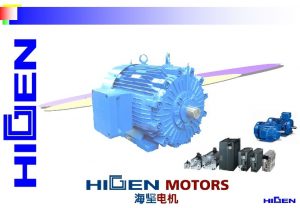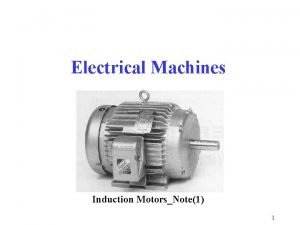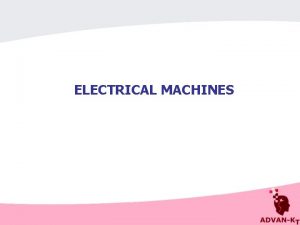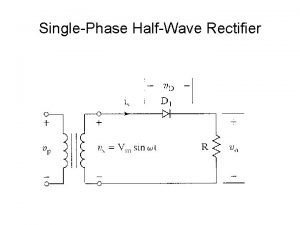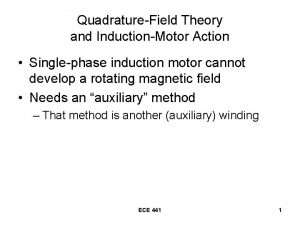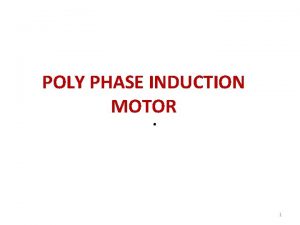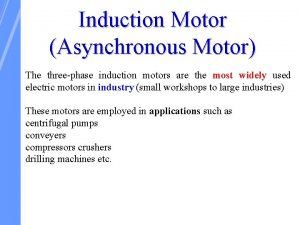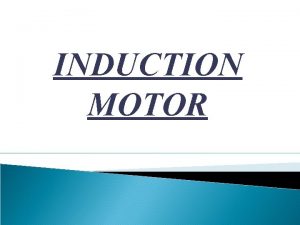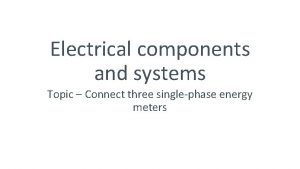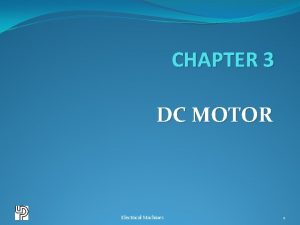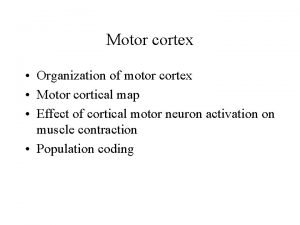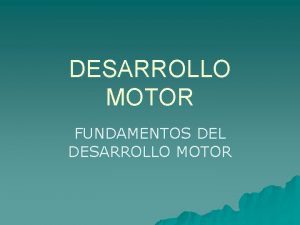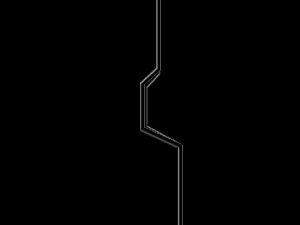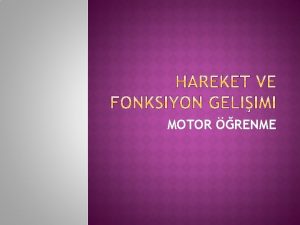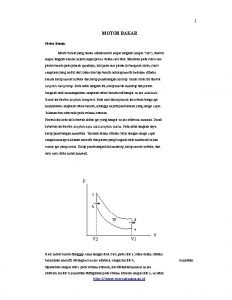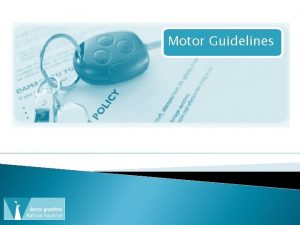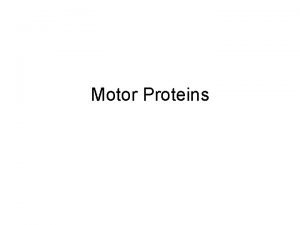CHAPTER 8 SINGLEPHASE INDUCTION MOTOR Electrical Machines 1




















- Slides: 20

CHAPTER 8 SINGLE-PHASE INDUCTION MOTOR Electrical Machines 1

INTRODUCTION • A single-phase induction motor is structurally similar to a three-phase induction motor; the difference is only in the stator winding arrangements. The stator windings of a singlephase induction motor are distributed, pitched and skewed to produce a sinusoidal m. m. f. in space. Electrical Machines 2

CONSTRUCTION • The construction of a single-phase induction motor is similar to that of a three-phase induction motor. The single-phase motor stator has a laminated iron core with two windings arranged perpendicularly – one is the main and the other is the auxiliary winding or starting winding. The motor uses a squirrel-cage rotor, which has a laminated iron core with slots in it. Single-phase induction motor is not self-starting and requires some mechanism to assist it in the starting process. Electrical Machines 3

DOUBLE-FIELD REVOLVING THEORY • According to this theory, a pulsating field of a single-phase motor can be resolved into two rotating field of half its amplitude rotating in opposite direction at synchronous speed. Electrical Machines 4

DOUBLE-FIELD REVOLVING THEORY Electrical Machines 5

DOUBLE-FIELD REVOLVING THEORY • The torque–slip curve is shown below Electrical Machines 6

CROSS FIELD THEORY • When a single-phase supply is given to the stator of a single-phase induction motor, an alternating flux is produced in the stator. • This alternating flux will produce an induced e. m. f. in the rotor windings, which is initially at standstill. • No torque will be produced in the rotor Electrical Machines 7

CROSS FIELD THEORY • If the rotor is rotated by giving some external force, an e. m. f. will be induced in the rotor and thus a current will flow through the rotor. This current will be displaced by 90 degree (electrical) from the stator axis. Electrical Machines 8

STARTING OF SINGLE-PHASE INDUCTION MOTOR Some of the starting methods are, i) Split-phase method ii) Shaded-pole method iii) Reluctance-start method Electrical Machines 9

Split Phase Method The different split-phase techniques are: i) Split-phase resistance-start motor. ii) Split-phase capacitor-start motor. iii) Capacitor-start – capacitor-run induction motor iv) Permanent single capacitor induction motor. Electrical Machines 10

Split-phase resistance start motor This method of starting is mostly used in motor with low inertia load or continuous operating load. Electrical Machines 11

Split-phase capacitor start motor In this type of motor, an electrolytic capacitor is connected in series with the auxiliary winding. Due to the presence of the capacitor, the auxiliary winding current will now lead the applied voltage and the main winding current will lag the applied voltage. Electrical Machines 12

Capacitor-start – Capacitor-run induction motor These motors are used for such applications where large starting torque and quiet operations are required. These motors produce constant torque and have better efficiency and power factor. Electrical Machines 13

Shaded Pole Method A part of each pole is wrapped with low resistance copper bands, which form a closed loop (These copper bands are called shading bands or shaded poles). Electrical Machines 14

Shaded Pole Method • When a single-phase AC supply is given to the stator of an induction motor, alternating flux will set up a current in the shading bands. • The flux in the shaded poles will lag the stator flux. The result is similar to a rotating field moving from un-shaded to shaded portion of the pole. This will produce the starting torque. Electrical Machines 15

EQUIVALENT CIRCUIT OF A SINGLEPHASE INDUCTION MOTOR Equivalent circuit at stand still based on doublefield revolving theory Electrical Machines 16

EQUIVALENT CIRCUIT OF A SINGLEPHASE INDUCTION MOTOR Equivalent circuit at any slip Electrical Machines 17

Block Rotor Test • Blocked rotor test is conducted on an induction motor. It is also known as short circuit test or locked rotor test or stalled torque test. • From this test short-circuit current at normal voltage, power factor on short-circuit, total leakage reactance, starting torque of the motor can be found. • The test is conducted at low voltage because if the applied voltage was normal voltage then Electrical Machines 18

No-load Test • In this test, the rotor is made to rotate freely without any load. • Under this condition, the slip due to forward rotating field will reach zero and the slip due to backward rotating field will be 2. Electrical Machines 19

COMPARISON OF SINGLE-PHASE AND THREE-PHASE INDUCTION MOTOR • Single-phase induction motors are simple in construction, reliable and economical for small power rating as compared to three-phase induction motors. • The electrical power factor of single-phase induction motors is low as compared to threephase induction motors. • For the same size, single-phase induction motors develop about 50% of the output as that of threephase induction motors. Electrical Machines 20
 Magnetic materials used in electrical machines
Magnetic materials used in electrical machines Principles of electrical machines vk mehta
Principles of electrical machines vk mehta What is hunting in synchronous motor
What is hunting in synchronous motor Synchronous speed of motor
Synchronous speed of motor Air gap power in induction motor formula
Air gap power in induction motor formula Power flow diagram of motor
Power flow diagram of motor Speed control of squirrel cage induction motor
Speed control of squirrel cage induction motor Repulsion start induction run motor
Repulsion start induction run motor Construction of linear induction motor
Construction of linear induction motor Rotor frequency formula
Rotor frequency formula Slip speed of induction motor
Slip speed of induction motor Ee2352 solid state drives
Ee2352 solid state drives 4 quadrant operation of induction motor
4 quadrant operation of induction motor 3-phase induction motor problems and solutions
3-phase induction motor problems and solutions Starting torque of induction motor
Starting torque of induction motor Double sided linear induction motor
Double sided linear induction motor Concentric winding diagram
Concentric winding diagram Single phase induction motor
Single phase induction motor Stator voltage control of induction motor
Stator voltage control of induction motor Repulsion start induction run motor
Repulsion start induction run motor Higen 3 phase induction motor
Higen 3 phase induction motor
